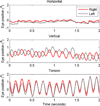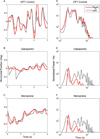Acquired pendular nystagmus
- PMID: 28320194
- PMCID: PMC5363284
- DOI: 10.1016/j.jns.2017.01.033
Acquired pendular nystagmus
Abstract
Acquired pendular nystagmus is comprised of quasi-sinusoidal oscillations of the eyes significantly affecting gaze holding and clarity of vision. The most common causes of acquired pendular nystagmus include demyelinating disorders such as multiple sclerosis and the syndrome of ocular palatal tremor. However, several other deficits, such as pharmacological intoxication, metabolic and genetic disorders, and granulomatous disorders can lead to syndromes mimicking acquired pendular nystagmus. Study of the kinematic features of acquired pendular nystagmus has suggested a putative pathophysiology of an otherwise mysterious neurological disorder. Here we review clinical features of neurological deficits that co-occur with acquired pendular nystagmus. Subsequent discussion of the pathophysiology of individual forms of pendular nystagmus speculates on mechanisms of the underlying disease while providing insights into pharmacotherapy of nystagmus.
Keywords: Degenerative disorder; Demyelination disorder; Multiple sclerosis; Stroke; Toxin exposure.
Copyright © 2017 Elsevier B.V. All rights reserved.
Figures





Similar articles
-
Acquired pendular nystagmus with oscillopsia in multiple sclerosis: a sign of cerebellar nuclei disease.J Neurol Neurosurg Psychiatry. 1974 May;37(5):570-7. doi: 10.1136/jnnp.37.5.570. J Neurol Neurosurg Psychiatry. 1974. PMID: 4836752 Free PMC article.
-
Acquired pendular nystagmus in multiple sclerosis and oculopalatal tremor.Neurology. 2011 May 10;76(19):1650-7. doi: 10.1212/WNL.0b013e318219fa9c. Neurology. 2011. PMID: 21555732
-
Therapy for nystagmus.J Neuroophthalmol. 2010 Dec;30(4):361-71. doi: 10.1097/WNO.0b013e3181e7518f. J Neuroophthalmol. 2010. PMID: 21107124 Review.
-
Damping of monocular pendular nystagmus with vibration in a patient with multiple sclerosis.Neurology. 2014 Apr 15;82(15):1380-1. doi: 10.1212/WNL.0000000000000324. Epub 2014 Mar 14. Neurology. 2014. PMID: 24634455 Free PMC article.
-
An update on acquired nystagmus.Semin Ophthalmol. 2008 Mar-Apr;23(2):91-7. doi: 10.1080/08820530801888089. Semin Ophthalmol. 2008. PMID: 18320475 Review.
Cited by
-
Eye Movement Abnormalities in Multiple Sclerosis: Pathogenesis, Modeling, and Treatment.Front Neurol. 2018 Feb 5;9:31. doi: 10.3389/fneur.2018.00031. eCollection 2018. Front Neurol. 2018. PMID: 29467711 Free PMC article. Review.
-
Horizontal Pendular Nystagmus and Ataxia Secondary to Severe Hypomagnesemia.Tremor Other Hyperkinet Mov (N Y). 2024 Jul 22;14:38. doi: 10.5334/tohm.910. eCollection 2024. Tremor Other Hyperkinet Mov (N Y). 2024. PMID: 39070062 Free PMC article.
-
Electro-Encephalography and Electro-Oculography in Aeronautics: A Review Over the Last Decade (2010-2020).Front Neuroergon. 2020 Dec 21;1:606719. doi: 10.3389/fnrgo.2020.606719. eCollection 2020. Front Neuroergon. 2020. PMID: 38234309 Free PMC article. Review.
-
A dynamical method to objectively assess infantile nystagmus based on eye tracking. A pilot study.J Optom. 2023 Jul-Sep;16(3):221-228. doi: 10.1016/j.optom.2023.01.002. Epub 2023 Jan 23. J Optom. 2023. PMID: 36697270 Free PMC article.
-
Non-nystagmus hyperkinetic eye movement disorders.Neurol Sci. 2025 Jul;46(7):3021-3038. doi: 10.1007/s10072-024-07873-2. Epub 2025 Mar 13. Neurol Sci. 2025. PMID: 40080371 Review.
References
-
- Cannon SC, Robinson DA. An improved neural-network model for the neural integrator of the oculomotor system: more realistic neuron behavior. Biological cybernetics. 1985;53:93–108. - PubMed
-
- Cannon SC, Robinson DA. Loss of the neural integrator of the oculomotor system from brain stem lesions in monkey. Journal of neurophysiology. 1987;57:1383–1409. - PubMed
-
- Cannon SC, Robinson DA, Shamma S. A proposed neural network for the integrator of the oculomotor system. Biological cybernetics. 1983;49:127–136. - PubMed
-
- Robinson DA. The effect of cerebellectomy on the cat’s bestibulo-ocular integrator. Brain research. 1974;71:195–207. - PubMed
-
- Frohman EM, Frohman TC, Zee DS, McColl R, Galetta S. The neuro-ophthalmology of multiple sclerosis. The Lancet Neurology. 2005;4:111–121. - PubMed
Publication types
MeSH terms
Grants and funding
LinkOut - more resources
Full Text Sources
Other Literature Sources
Medical

